Fig. 1.
The FXR agonist GW4064 improved fasting blood glucose and inhibited the translocation of PGC1α and FOXO1 from the nucleus to the cytoplasm in gluconeogenesis with FK506 treatment in mice for 3 months. a After FK506 was administered at a dose of 1 mg/kg/day to the C57BL/6J mice for 3 months, the fasting blood glucose levels obviously increased gradually compared with those of the control group, and the FXR agonist GW4064 downregulated the blood glucose levels. No significant difference was found for b body weights and c morphological alterations among the control group, the FK506 group and the FK506 + GW4064 group. The C-1, C-2 and C-3 groups were the control group, the FK506 group and the FK506 + GW4064 group, respectively. d, f–h, j, k Western blotting and quantitative analysis show the protein subcellular localization of PGC1α and FOXO1. Original magnification, ×3400 in each group. e, i IF staining for PGC1α (e) and FOXO1 (i) in sections of 3 groups. DAPI was used to locate the nuclei of the cells. Data are presented as the mean ± SD (n = 7). *P < 0.05 vs. the control group, #P < 0.05 vs. the FK506 group

